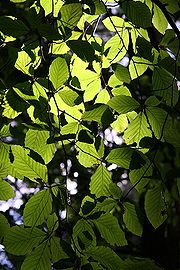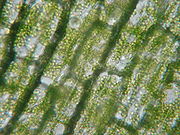Chlorophyll
Contents
» Chlorophyll and photosynthesis» Chemical structure
» Spectrophotometry
» Biosynthesis
» Culinary Use
» References
Chlorophyll and photosynthesis
Chlorophyll molecules are specifically arranged in and around pigment protein complexes called photosystems which are embedded in the thylakoid membranes of chloroplasts. In these complexes, chlorophyll serves two primary functions. The function of the vast majority of chlorophyll (up to several hundred molecules per photosystem) is to absorb light and transfer that light energy by resonance energy transfer to a specific chlorophyll pair in the reaction center of the photosystems. Because of chlorophyll’s selectivity regarding the wavelength of light it absorbs, areas of a leaf containing the molecule will appear green.

Chlorophyll gives leaves their green colour

Chlorophyll is found in high concentrations in chloroplasts of plant cells.

SeaWIFS-derived average sea surface chlorophyll for the period 1998 to 2006.

Space-filling model of the chlorophyll a molecule
The function of the reaction center chlorophyll is to use the energy absorbed by and transferred to it from the other chlorophyll pigments in the photosystems to undergo a charge separation, a specific redox reaction in which the chlorophyll donates an electron into a series of molecular intermediates called an electron transport chain. The charged reaction center chlorophyll (P680+) is then reduced back to its ground state by accepting an electron. In Photosystem II, the electron which reduces P680+ ultimately comes from the oxidation of water into O2 and H+ through several intermediates.
Photosystem I typically works in series with Photosystem II, thus the P700+ of Photosystem I is usually reduced, via many intermediates in the thylakoid membrane, by electrons ultimately from Photosystem II. Electron transfer reactions in the thylakoid membranes are complex, however, and the source of electrons used to reduce P700+ can vary.
The electron flow produced by the reaction center chlorophyll pigments is used to shuttle H+ ions across the thylakoid membrane, setting up a chemiosmotic potential mainly used to produce ATP chemical energy, and those electrons ultimately reduce NADP+ to NADPH a universal reductant used to reduce CO2 into sugars as well as for other biosynthetic reductions.
Reaction center chlorophyll-protein complexes are capable of directly absorbing light and performing charge separation events without other chlorophyll pigments, but the absorption cross section (the likelihood of absorbing a photon under a given light intensity) is small. Thus, the remaining chlorophylls in the photosystem and antenna pigment protein complexes associated with the photosystems all cooperatively absorb and funnel light energy to the reaction center. Besides chlorophyll a, there are other pigments, called accessory pigments, which occur in these pigment-protein antenna complexes.
Chemical structure
The different structures of chlorophyll are summarized below:
| Chlorophyll | Molecular formula | C3 group | C7 group | C8 group | C17 group | C17-C18 bond | Occurrence |
|---|---|---|---|---|---|---|---|
| Chlorophyll a | C55H72O5N4Mg | -CH=CH2 | -CH3 | -CH2CH3 | -CH2CH2COO-Phytyl | Single | Universal |
| Chlorophyll b | C55H70O6N4Mg | -CH=CH2 | -CHO | -CH2CH3 | -CH2CH2COO-Phytyl | Single | Mostly plants |
| Chlorophyll c1 | C35H30O5N4Mg | -CH=CH2 | -CH3 | -CH2CH3 | -CH=CHCOOH | Double | Various algae |
| Chlorophyll c2 | C35H28O5N4Mg | -CH=CH2 | -CH3 | -CH2CH3 | -CH=CHCOOH | Double | Various algae |
| Chlorophyll d | C54H70O6N4Mg | -CHO | -CH3 | -CH2CH3 | -CH2CH2COO-Phytyl | Single | cyanobacteria |
When leaves degreen in the process of plant senescence chlorophyll is converted to a group of colourless tetrapyrroles known as nonfluorescent chlorophyll catabolites (NCC's) with the general structure:
Spectrophotometry
» In diethyl ether, chlorophyll a has approximate absorbance maxima of 430 nm and 662 nm, while chlorophyll b has approximate maxima of 453 nm and 642 nm.
» The absorption peaks of chlorophyll a are at 665 nm and 465 nm. Chlorophyll a fluoresces at 673 nm. The peak molar absorption coefficient of chlorophyll a exceeds 105 M−1 cm−1, which is among the highest for organic compounds.
Biosynthesis
In plants, chlorophyll may be synthesized from succinyl-CoA and glycine, although the immediate precursor to chlorophyll a and b is protochlorophyllide. In Angiosperms, the last step, conversion of protochlorophyllide to chlorophyll, is light-dependent and such plants are pale (etiolated) if grown in the darkness. Non-vascular plants and green algae have an additional light-independent enzyme and grow green in the darkness as well. Chlorophyll itself is bound to proteins and can transfer the absorbed energy in the required direction.
Absorbance spectra of free chlorophyll a (green) and b (
red
) in a solvent. The spectra of chlorophyll molecules are slightly modified in vivo depending on specific pigment-protein interactions.Chlorosis is a condition in which leaves produce insufficient chlorophyll, turning them yellow. Chlorosis can be caused by a nutrient deficiency including iron - called iron chlorosis, or in a shortage of magnesium or nitrogen. Soil pH sometimes play a role in nutrient-caused chlorosis, many plants are adapted to grow in soils with specific pHs and their ability to absorb nutrients from the soil can be dependent on the soil pH. Chlorosis can also be caused by pathogens including viruses, bacteria and fungal infections or sap sucking insects.
Culinary Use
References
- Speer, Brian R. (1997). "Photosynthetic Pigments" in UCMP Glossary (online). University of California, Berkeley Museum of Paleontology. Verified availability March 12, 2007.- Marker, A. F. H. (1972), "The use of acetone and methanol in the estimation of chlorophyll in the presence of phaeophytin", Freshwater Biology 2: 361.
- Jeffrey, S. W. (February 1969), "SOME SPECTRAL CHARACTERISTICS OF CHLOROPHYLL c FROM TRIDACNA CROCEA ZOOXANTHELLAE", Biol Bull 136: 54–62.
- R. B. Woodward, W. A. Ayer, J. M. Beaton, F. Bickelhaupt, R. Bonnett, P. Buchschacher, G. L. Closs, H. Dutler, J. Hannah, F. P. Hauck, S. Itô, A. Langemann, E. Le Goff, W. Leimgruber, W. Lwowski, J. Sauer, Z. Valenta, and H. Volz (1960). "The total synthesis of chlorophyll" (PDF). Journal of the American Chemical Society 82: 3800-3802.
- Ian Fleming (October 1967). "Absolute Configuration and the Structure of Chlorophyll". Nature 216: 151–152. ^ Robert Burns Woodward, William A. Ayer, John M. Beaton, Friedrich Bickelhaupt, Raymond Bonnett, Paul Buchschacher, Gerhard L. Closs, Hans Dutler, John Hannah, Fred P. Hauck, et al. (1990). "The total synthesis of chlorophyll a". Tetrahedron 46 (22): 7599-7659.
- Colourless Tetrapyrrolic Chlorophyll Catabolites Found in Ripening Fruit Are Effective Antioxidants Thomas Muller, Markus Ulrich, Karl-Hans Ongania, and Bernhard Krautler Angew. Chem. Int. Ed. 2007, 46, 8699 –8702.
- Adams, Jad (2004), Hideous absinthe : a history of the devil in a bottle, Madison, Wisconsin: University of Wisconsin Press, pp. 22.










